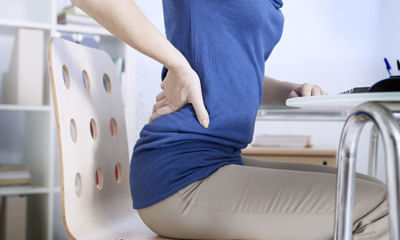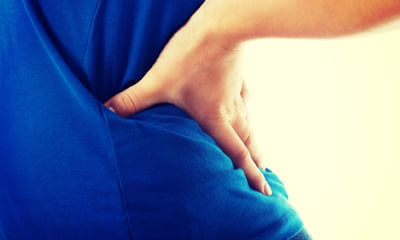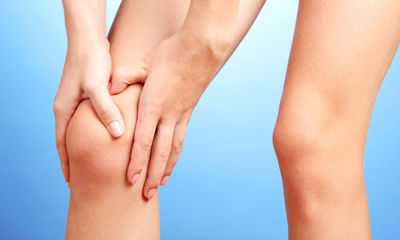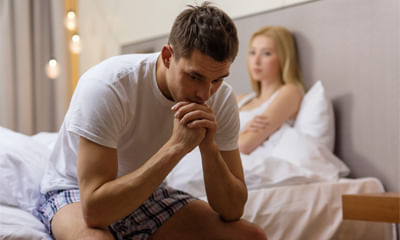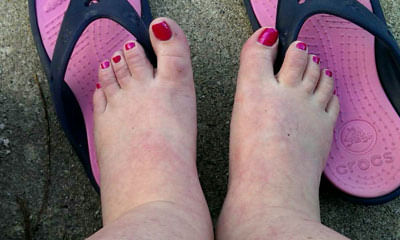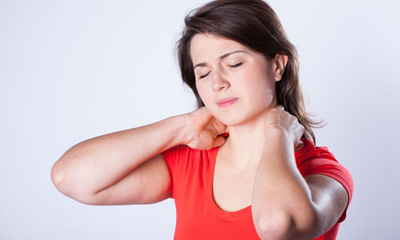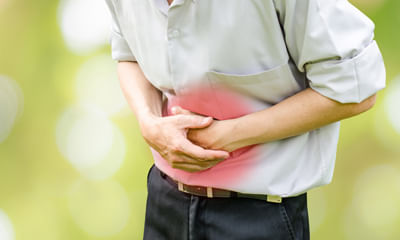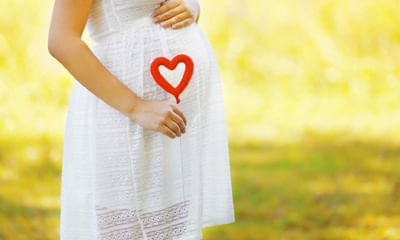Leg Stiffness During Pregnancy
I am 25 years old, I have been experiencing lower back pain, sore breasts, lose of appetite, bloating, constipation, leg ...
Ask Free Question
Since when r you having this? What r other symptoms that you r experiencing? By doing what like walking, exertion, eating or empty stomach- it increases or decreases in intensity. For how much time it remains? Is there stiffness also? How is your appetite? R you constipated or having loose stools? Any problem in urine? I need details of the case.in the meanwhile follow this 1. Take your breakfast every day. Don't skip it. U should eat whatever your mother or grandparent eat in bfast. I mean to say whatever is your traditional food. If punjabi eat paratha, if belongs to south then take idli/ dosa etc. 2. Don't overeat 3. Don't take tea empty stomach. Eat something like a banana (if you are not diabetic) or any seasonal fruit or soaked almonds and a glass of plain water first thing in the morning (preferably within 10 mins of waking up). No only biscuits or rusk will not do. 4. Have light meals every 2 hours (in addition to your breakfast, lunch n dinner) e.g. Nariyal paani, chaach, a handful of mixed dry fruits, a handful of peanuts, any fresh n seasonal fruit (eat whole fruit not juice), a cup of curd/milk etc 5. Take simple food like rice n dal in dinner. Finish your dinner at least 2 hours before going to sleep. 6. Maintain active life style 7. Avoid fast foods, spicy n fried foods, carbonated beverages 8. Take a lot of green vegetables n fruit. 9. Drink lot of water. 10. Everyday preferably sleep on same time 11. Take 1tsp of ghee in bfast, lunch n dinner. Exercise in the form of yoga, cycling, swimming, gym etc. Till lock down do suryanamaskar. Https://www.youtube.com/watch? V=wmhmazurgvsandfeature=youtu. Be homeopathy is a very effective for this problem n has very encouraging results. For details, consult online.
I am 28 years female and I am suffering from back pain should I plan for pregnancy? Please help me. ...
Ask Free Question
Because your kidneys are located toward your back and underneath your ribcage, it may be hard to tell if the pain you’re experiencing in that area is coming from your back or your kidney. The symptoms you’re having can help you figure out which is the source of the pain. The location, type, and severity of the pain are some of the things that will be different depending on whether the pain is from a problem in your kidneys or your back. How to identify kidney painkidney pain is most often caused by a kidney infection or a stone in the tubes coming out of your kidney. If the pain is coming from your kidney, it will have these features: where the pain is located kidney pain is felt in your flank, which is the area on either side of your spine between the bottom of your ribcage and your hips. It usually occurs in one side of your body, but it can occur in both sides. Type of pain kidney pain is usually sharp if you have a kidney stone and a dull ache if you have an infection. Most often it will be constant. It won’t get worse with movement or go away by itself without treatment. If you’re passing a kidney stone, the pain may fluctuate as the stone moves. Radiation of the pain sometimes the pain spreads (radiates) to your inner thigh or lower abdomen. Severity of the pain kidney pain is classified according to how bad it is — severe or mild. A kidney stone usually causes severe pain, and the pain from an infection is usually mild. Things that make it better or worse typically, nothing makes the pain better until the problem is corrected, such as by passing the stone. Unlike back pain, it usually won’t change with movement. Accompanying symptoms if you have a kidney infection or a kidney stone, you may also experience: •fever and chills •nausea and vomiting •cloudy or dark urine •an urgent need to urinate •pain when you urinate •a recent infection in your bladder •blood in your urine (this can happen with an infection or kidney stones) •small kidney stones that look like gravel in your urine how to identify back pain back pain is more common than kidney pain and is usually caused by a problem in the muscles, bones, or nerves in your back. Has the following features: where the pain is located back pain can occur anywhere on your back, but it’s most commonly located in your lower back or one of your buttocks. Type of pain muscle pain feels like a dull ache. If a nerve has been injured or irritated, the pain is a sharp burning sensation that may travel down your buttock to your lower leg or even your foot. Muscle pain may affect one or both sides, but nerve pain usually only affects one side. Radiation of the pain nerve pain may spread to your lower leg. Pain from a muscle usually stays in the back. Severity of the pain back pain is described as acute or chronic based on how long you’ve had it. Acute pain lasts days to weeks, subacute pain lasts six weeks to three months, and chronic pain lasts longer than three months. Things that make it better or worse back pain may get worse with movement or if you sit or stand for a long time. It may get better if you switch positions or walk around. Accompanying symptoms other symptoms you may experience with back pain include: •the painful spot looking swollen and feeling tender to the touch •a muscle spasm in the painful area •numbness or weakness in one or both of your legs (if the pain is due to a nerve issue) if you find you have back pain and can’t hold your urine or bowel movements, something is pressing on your spinal nerves, and you should be evaluated immediately. This condition, called cauda equina syndrome, can cause severe long-term damage to your spinal nerves if not treated right away. 6 imbalances that cause pain—and how to fix them "pain is a medical condition and a medical issue, says brett jones, owner of applied strength in pittsburgh who is certified for the functional movement screen, a system of tests and cor rective exercise strategies. "it's a warning sign. The pain is there to tell you something's wrong. And that warning sign could be more serious than "you're going too hard. Jones and the other coaches consulted for this piece all had a horror story to tell-when pain in a client meant a more serious condition such as a nerve issue, thyroid issue, or even cancer. The point: if you experience regular pain while exercising-or when you're not-go to the doctor. If you've been cleared by a doc and you're still feeling discomfort, try these simple tests to see what's truly causing the pain-it could be related to an imbalance in a completely different part of your body. The good news: with these drills, stretches, and corrective exercises, you may be able to fix them-no doctors necessary. Neck pain and headaches? Could be your shoulders. If you're experiencing these symptoms and have been cleared by a doctor, check out the height of your shoulders, says aaron brooks, a biomechanics expert and owner of perfect postures in auburndale, ma. "look in the mirror and see if one shoulder is higher or lower than the other, he says. If one of your shoulders is higher than the other, you'll be strengthening one more than the other, and it may wind up pulled forward more than the other-resulting an inward rotation of that hand. "when you do a row or a press, that side's going to get pinched. There's less room in the shoulder. You can wind up with bursitis or tendonitis. Or headaches and neck pain. Fix it: if the mirror test shows they're uneven, try this single-arm doorway stretch, brooks says. To do it, stand inside the threshold of a door, and place your right forearm inside the door on the right side of the jamb, palm against the jamb at about shoulder height. In this position, twist your chest slightly through the door to stretch your chest-alternately, you can take a step forward with your right foot, keeping your left foot in the threshold. This stretch will open your chest muscles and create room in your shoulder for movement. Pair that stretch with this mid-back strengthening exercise: grab a resistance band and stretch it in front of your chest so that your arms are straight out to the sides from your shoulders, palms facing up. At the full extension of your arms, the band should be stretched out. Return to clap your hands in front, and repeat the movement. Pair these two moves-in this order-three times per week. Shoulders even? Your headaches could be from a forward-leaning head. If you don't see an imbalance in the height of your shoulders, turn to the side, says robert taylor, owner of smarter team training in baltimore. If your head is jutting far forward of your shoulders, it could ultimately decrease the amount of blood flow to your head and neck. "the head leans forward, the spine leans forward, and it puts unnecessary stress on the lower spine too, he says. With the decreased blood flow to your thinking cap, you could get headaches. Fix it: increase blood flow up top and return your head to its natural, up-tall position by strength training your neck, taylor says. Try this one-arm shrug to even things out: sit on an upright bench, like one you'd use for a shoulder press. Holding a dumbbell in your right hand, place your left hand under your left butt cheek and grab the side of the seat. Let your right hand hang down straight by your side and pull your shoulder blades back and together. Now raise your right shoulder up towards your ear-raise it straight up instead of rolling your shoulder. Hold for a beat at the top, and then return to the start position. Complete a set of 10, and repeat on the other side. Knee pain when you run? Could be your hips. "the knee has two bad neighbors-the hip and the ankle, jones says. The pain you feel in your knee could very well be tightness or immobility in those bad neighbors. "they sweep all their leaves into the knee's yard. Everyone blames the knee, but it's the neighbors. To see if your hips have a proper level of mobility, lay on your back in a doorway so that the middle of your kneecap is right on the threshold. Relax your arms at your sides, palms up. Bring your feet together, toes pointed at the ceiling. Pull your toes towards your shins to create a 90-degree angle at the ankle. Keep one leg straight and still as you slowly raise the other leg until either your knee bends on your raising leg, or your bottom foot bends or turns out to the side. "see if the knobby part of your ankle can make it past the door frame, jones says. If it does, your hips are plenty mobile-check the ankle test below to see if that's causing some knee issues. If either ankle can't make it, foam roll your hips and glutes, and then work on this stretch using a belt or strap for instant improvement. Fix it: lying in the same position as during the test, wrap a strap or belt around one foot and raise it until you just start to feel a stretch-not to the level where it's all the stretch you can take, but just the beginning of the stretch, jones says. Once here, bring your other leg up to meet it. Return the non-strapped leg to the floor. At this point, you may find that the strapped leg can come up a little higher. When it does, bring the non-strapped leg up to meet it again. Continue until you no longer feel progress in the strapped leg, and switch. Hips moving ok? Check your ankles. If your hips are mobile (and even if they're not), ankle mobility can also lead to knee pain, says mike perry, owner of skill of strength in north chelmsford, mass. Who is certified in the functional movement screen. To see how mobile your ankles are (or aren't), assume a one-knee position facing a wall. Your knees should both form 90-degree angles, and the toe of your planted foot should be about four inches from the wall. In this position, perry says, try to glide your knee over the pinky toe to touch the wall without lifting your heel. If you can reach the wall, your ankle is gliding correctly. If your foot comes up before your knee touches the wall, your calves are "incredibly tight, perry says. Fix it: to help remedy this issue, foam roll your calves and try this variation on that ankle test from brett jones. Assume the same half-kneeling position, and place the point of a broomstick on the pinky toe of your planted foot. Hold the stick so it's touching the outside of your knee. With the stick in this position, keeping your knee from flaring out to the side, glide the knee forward slowly, stopping when your heel leaves the ground. If you perform this as a drill, jones says, you can see as much as half an inch of improvement in the first session. If you feel pain during the drill, stop and consult a physician. Lower-back tightness? Might be your hips. As with knee pain, back discomfort often isn't a back problem at all, brooks says. If one side of your pelvis is higher than the other, it can result in back pain, hip pain, groin pain, or even knee pain. "if you try to do a lunge, the knee on the high side will cave in and the hip will angle inward, brooks says. The repercussions of this change over time can be knee pain, a patella tear, a medial meniscus injury, or hip bursitis. But back to your back-the unevenness of your hips can pull on your lower back, causing that tightness while sitting all day. Fix it: if you notice your hips are uneven, try this hip abduction exercise. Lie on your back with knees bent and feet flat on the floor, hip-width apart (the classic sit-up position). Wrap a small resistance band around your knees so that it's already a little tight while your knees are together. Now press out against the strap to separate your knees until they form a v-shape, holding at the outermost edge of the press for a few moments. This move helps to fix the hip imbalance because "in the lying position, the muscles that are causing the pelvis to be out of alignment are shut off, brooks says. Repeat for 2 sets of 20 reps, 3 times per week. Tail bone pain the lower end of the vertebral column is inflamed and that bone is called coccyx bone and the condition is called coccydynia. The conservative management would be to keep ice in that inflamed area during one time in a day and also to sit in a hot water bowl where the penetration of the heat would help to reduce the inflammation. And to reduce the weight falling on the inflammed surface we suggest patients to use air cushion pillow (also called as doughnut pillow) where in the buttock's weight will not fall exactly on the painful tail bone and that would automatically reduce the pain. For this the best treatment would be to undergo ultrasonic therapy in one of the nearby physiotherapy clinics.
I am 32 years female with 2 c section delivery. Last c section was in april 2021. I am now suffering with terrible back ...
Ask Free Question
Cold compresses can help reduce swelling in the area. Cooling also helps to numb sharp pain. Apply an ice pack for up to 20 minutes, up to five times a day. Use a frozen gel pack, ice cubes in a plastic bag, or a bag of frozen peas. Wrap the cold pack in a soft towel. Do not apply a cold pack directly to skin. Heat therapy heat helps to relax tense muscles and soothe a stiff area. It can help with muscle pain and bonny pain. Use a heated gel pack, heating pad or a hot water bottle.
Hello, I am 34 year old female. I have a condition sacroiliitis since 3 year, not taking any medicine for now. I have li ...
Ask Free Question
Follow these herbal combinations for complete cure before planning pregnancy ras raj ras 1 tablet twice a day vatari awleh 10 gm twice a day.
Sex ke bad sperm bhar as jata hai. Kitni der bhi lete raho tab bhi sab bhar aa jata hai. Or ander kuch feel bhi nahi hot ...
Ask Free Question
Hello- this is very normal and let's talk about why. Ejaculate (the stuff that comes out when a man ejaculates) is made up of a lot of different things. One of its components is sperm. In a normal male ejaculate, there are anywhere between 20 and 400 million sperm. All you need to get pregnant is one. What normally happens after intercourse, is that a lot of the ejaculate does leak out. Some of it, however, remains in the back of the vagina (in the posterior fornix) and an even smaller amount makes its way up through the cervix, into the uterus and down the fallopian tubes. It is here, in the fallopian tubes, that the sperm and egg meet. So, the bottom line is that you don't need to lie in bed with your legs up after intercourse to get pregnant and the fact that semen is leaking out afterwards, doesn't decrease your chances of conceiving.
Ek mahine se mere left leg me pain ho raha he, 10 minute bhi khadi hona ya chalna mushkil hogaya he ,pure leg me special ...
Ask Free Question
Do the cat/cow stretch. Get on all fours, with your arms straight and your hands directly under your shoulders; your knees hip-width apart. Core strengthening exercises- straight leg raised with toes turned outward, repeat 10 times, twice a day. Back stretching- lie flat, pull one of the knee forward to chest, hold for 3 seconds, then bring the other knee forward to the chest and again hold for 3 seconds. Then pull both knees towards the chest and hold for 3 seconds. Repeat 10 times each eHi. Developed constant pain in left leg's toe joint since few month, could you please help diagnose. .excercise twice a day. Bhujang asana – lie flat on your stomach, keeping the palms out, bend the neck backward, take a deep breath and while holding it for 6 seconds, raise the chest up. Release breath and relax your body. Repeat the exercise 15 times twice daily. chiropractic adjustment will help. Extension exercises x 15 times x twice daily - lying on tummy, take left arm up for 3 seconds, then bring it down, right arm up for 3 seconds, bring down. Bring right leg up, hold for 3 seconds, bring it down. Then right leg up and hold for 3 seconds and bring it down. Repeat twice a day- 10 times. chiropractic mobilization will help. Postural correction- sit tall, walk tall, stand tall. chiropractic adjustment will help. Back stretching. Do the cat/cow stretch. Core strengthening chiropractic mobilization will help. Postural correction- sit tall, walk tall. Extension exercises x 15 times x twice daily. Apply hot fomentation twice daily. Avoid bending in front. Back pain 3chiropractic adjustment will help. Avoid squatting- contrast fomentation (hot and cold) avoid sitting cross legged back pain 2 chiropractic adjustment will help. Do the cat/cow stretch. Get on all fours, with your arms straight and your hands directly under your shoulders; your knees hip-width apart. Back pain chiropractic adjustment will help. Apply hot fomentation twice daily. Avoid bending in front. Chiropractic postural correction- sit tall, walk tall. Extension exercises x 15 times x twice daily - lying on tummy, take left arm up for 3 seconds, then bring it down, right arm up for 3 seconds, bring down. Bring right leg up, hold for 3 seconds, bring it down. Then right leg up and hold for 3 seconds and bring it down. Repeat twice a day- 10 times bhujang asana -- lie flat on your stomach, keeping the palms out, bend the neck backward, take a deep breath and while holding it for 6 seconds, raise the chest up. Release breath and relax your body. Repeat the exercise 15 times twice daily. Core strengthening exercises- straight leg raised with toes turned outward, repeat 10 times, twice a day. Chiropractic treatment. chiropractic adjustment will help. Get a custom made insole. Hot fomentation. Plantar fasciitisstretching exercises: chiropractic adjustment will help. •use a rolling pin or tennis ball. While seated, roll the rolling pin or ball with the arch of your foot. If you are able to, progress to doing this exercise while you are standing up. •toe stretch. •towel stretch. •calf stretch. Knee1chiropractic adjustment will help. Contrast fomentation (hot and cold). Avoid squatting- avoid sitting cross legged knee 2 chiropractic adjustment will help. Avoid squatting- contrast fomentation (hot and cold) avoid sitting cross leggedknee 1 chiropractic adjustment will help. Quadriceps exercise hams stretching- lie straight, take the leg up, pull the feet towards yourself, with a elastic tube ornormal belt. Repeat 10 times, twice a day. Sports taping- stretch the tape from both ends and apply on the affected area contrast fomentation (hot and cold). Chiropractic physiotherapy. Headache exercise. a good way to diffuse general body pains: 1.take a long hot bath in water in which a few cups of epsom salts have been added. 2.if you suspect your body and pains are due to stress-get plenty of sleep and try to reduce or eliminate the cause of your stress. 3.meditation, deep breathing and yoga. Neck advice chiropractic adjustment will help. Stretch claves get a custom made insole. Hot fomentation. Hand- advice chiropractic adjustment will help. Hot and cold pack fomentation. Gentle stretchingof hand muscles. Ball exercises.Wrist exerciser.Exercise varicose vain start walking, running, cycling. Repeat this cycle 2 to 4 times. Pain lag chiropractic adjustments will help contrast fomentation (hot and cold) avoid squatting- avoid sitting cross legged.Quadriceps strengthening exercises- quad clenches: lie flat on your back or sit upright on a chair with leg kept horizontally on another surface. Now, tighten the muscle on the front of the thigh by pushing your knee down. You should feel your thigh muscles clench, hold for 3 secs. Repeat 10 times twice a day. Short arcs: lie flat on your back or sit upright with your leg placed horizontally on a flat surface like a chair or bed. Place a rolled up towel under the knee. Pull your toes towards you and clench you thigh muscles. Slowly lift your foot up off the bed until your knee is straight (keep your knee resting on the towel). Hold for 3 secs and slowly lower them on the chair. Repeat 10 times twice a day. Straight leg raise: lie flat on your back. One leg and knee will be straight and other leg should be bent. Pull your toes towards you and tighten/clench the muscle on the front of the thigh, locking your knee straight. Lift your foot up in the air, about 6 inches off the bed. Hold for 3 secs and slowly lower the leg. The knee must remain straight the whole time you are doing this exercise. Chiropractic physiotherapy. Hamstring stretchingchiropractic adjustment will help. Towel hamstring stretch lie on the back, supporting the thigh with the hand or with a towel wrapped around it. Slowly straighten the knee until a stretch is felt in the back of the thigh, trying to get the bottom of the foot to face the ceiling, one leg at a time. Hold the position initially for 10 seconds, and gradually work up to 20 to 30 seconds. Seated hamstring stretch while sitting at the edge of a chair, straighten one leg in front of the body with the heel on the floor. Then, sit up straight and try pushing the navel towards the thigh without leaning the trunk of the body forwards. Hold this stretch for 30 seconds repeat 3 times for each leg. Chiropractic mobilization. Psoriatic arthritis exercise feet to fingertips: the benefits of stretching. Psoriatic arthritis can make it difficult to move, and that can interfere with your ability to work, play, and live an active lifestyle. One solution: follow a carefully planned set of stretching exercises designed to improve flexibility without adding to your joint pain. "stretching can provide localized muscle action. Back pain during pregnancy. Chiropractic adjustment will help. Stand up straight and tall. Hold your chest high. Keep your shoulders back and relaxed. Don't lock your knees. Calf stretches chiropractic adjustment will help. Standing calf stretch stand away from a wall and. Put your fight foot behind you and be sure your toes are facing forward. Lean forward at the ankle while bending the right knee and keeping your heel on the ground. Hold this for 30 to 60 seconds. Repeat 10 times a twice a day. Downward dog yoga stretch get down on all fours with your hands under your shoulders on the floor. Walk your hands forward slightly on the floor. Spread your fingers apart to allow for a broad base of support. Push your hips up toward the ceiling and tighten your abdominal muscles. Keep your heels on the ground and gently try and straighten your knees. Repeat 10 times a twice a day. Wall calf stretch stand about two feet away from a wall. Place the ball of your right foot against the wall while your heel remains on the ground. Slowly and gently lean into the wall while keeping your knee straight. Hold this for 5 seconds. Repeat 10 times twice a day. Downward dog yoga stretch get down on all fours with your hands under your shoulders on the floor. Walk your hands forward slightly on the floor. Spread your fingers apart to allow for a broad base of support. Push your hips up toward the ceiling and tighten your abdominal muscles. Keep your heels on the ground and gently try and straighten your knees. Hold this for the 5 seconds. Repeat 10 times twice a day. Contrast bath- fill two buckets/ tubs with very hot water and very cold water. Immerse your legs into the water for 3 minutes and then switch to cold water for 1 minute. Repeat this 3 times once a day. Advice. Chiropractic adjustment will help. Avoid sitting cross legged. Ankle stretching. Ankle strengthening exercises. Avoid squatting. Quadriceps exercises. Core strenthening exercises. Piriformis stretch chiropractic adjustment will help. Relax, and then repeat with the other leg. Repeat this cycle 2 to 4 times. Lie on your back. Cross your left leg over your right so that your left ankle rests on your right knee. Use your hands to grab hold of your left knee and pull it gently toward the opposite shoulder. Hold for 15 to 30 seconds. General body aches chiropractic adjustment will help. A good way to diffuse general body pains: 1.take a long hot bath in water in which a few cups of epsom salts have been added. 2.if you suspect your body and pains are due to stress-get plenty of sleep and try to reduce or eliminate the cause of your stress. 3.meditation, deep breathing and yoga. correct anterior pelvic tilt chiropractic adjustment will help. 1.correct posture during standing as well as during lifting any weight 2.gluteal squeezes while maintaing posterior pelvic tilt 3.stretchings of hip flexors: heel to buttocks in lying prone. Coccyx pain chiropractic adjustment will help. 1.ice packs2.ultrasonic therapy 3.cross over exercises 4.half squatting with wall support 5.stretching of front and back thigh muscles 4.knee to chest tennis elbow/golfer elbow chiropractic adjustment will help. 1. Ultrasonic therapy over the tenderness region 2. Ice pack 3. Stretching of forearm muscles volkmann ischemic contracture chiropractic adjustment will help. Goal: reduce swelling and improve the function of the damaged wrist, hand and fingers. 1. Splinting in severe cases 2. Stretching of forearm muscles. 3. Strengthening of forearm and wrist muscles. 4. Contrast fermentation of forearm and wrist musculature. Varicose veins chiropractic adjustment will help. Leg lifts – sit on the floor/mat or lie on your back with your feet straight out. Slowly, lift one leg at a time from the floor. Hold your leg in the air. Slowly, lower your leg back down to the floor. Repeat on the opposite leg. Calf raises – stand with your legs straight. Slowly, rise on to your tiptoes and then lower back down. Bicycle legs – lie on your back, bringing your legs in the air and bending them at the knee. Slowly, begin to pedal your legs as if you were riding a bicycle. You can also do the same motion one leg at a time, alternating your legs between sets.
I am 23, I have arms and legs pain especially in the joints since my medical abortion, its been 2 weeks. The blood test ...
Ask Free Question
Not related to medical abortion. Look into it if its because of fever or early morning stiffness. Add calcium and vitamin d if not adequate after a quick bleed test.
My child diagnosed by diplegic cerebral palsy what should I do for child so he can seat and walk early normally. ...
Ask Free Question
Neonatal asphyxia is the most common cause of diplegic cp, which generally happens when a newborn is deprived of oxygen during the delivery process. Infants born prematurely and with low birth weight have a heightened risk of developing diplegic cp as these babies are prone to oxygen problems during birth. Maternal infections, such as a high-grade fever or rubella during pregnancy also play a role in an infant develop diplegic cp. Diplegic cp is the least invasive type of cp, affecting mainly the legs. However, since hip dislocation is common, it’s highly recommended that people with diplegic cp begin regular hip check-ups as soon as possible. Orthopedic surgery is the most common type of surgery for children who have cp and entails correcting walking difficulties and unmanageable stiffness. Children must be at least 2 to 4 years of age before undergoing orthopedic surgery and must have major obstacles in their motor skills development.
Basically during the first trimester of pregnancy I had intense back pain which gradually went down to my leg too. Post ...
Ask Free Question
It is common to have post partum sacroileiitis which will subside one the pelvic ligaments come.back to.normal.after pregnancy Please do a CRP and ESR since you had extrapulmonary TB You can do post partum exercises Try to reduce the pain killers to minimum
Hi, I am in my 8th months of pregnancy and instantly I am feeling weight gain and swelling in my legs and fingers is it ...
Ask Free Question
Specifically, hypothyroidism may lead to: muscle aches, tenderness and stiffness, especially in the shoulders and hips. Joint pain and stiffness. Swelling of the small joints in the hands and feet.


